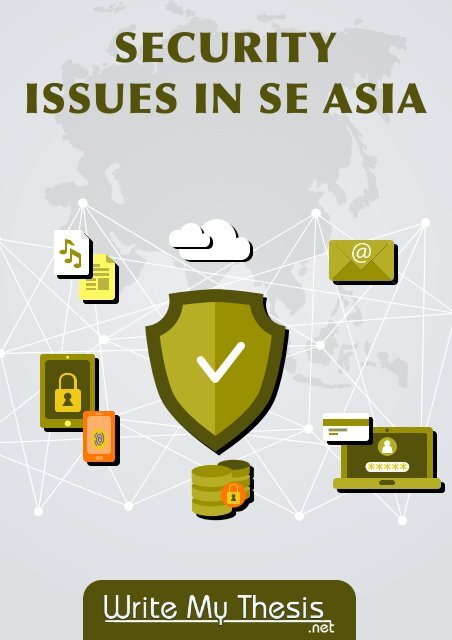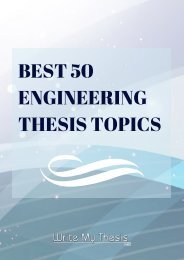Proposal: Security Issues in South East Asia
Are you looking for sample master thesis proposal? Check it out here https://www.writemythesis.net/
Are you looking for sample master thesis proposal? Check it out here https://www.writemythesis.net/
- No tags were found...
You also want an ePaper? Increase the reach of your titles
YUMPU automatically turns print PDFs into web optimized ePapers that Google loves.
SECURITY<br />
ISSUES IN SE ASIA
<strong>Proposal</strong>: <strong>Security</strong> <strong>Issues</strong> <strong>in</strong> <strong>South</strong> <strong>East</strong> <strong>Asia</strong><br />
Problem statement<br />
The 21st century is often referred to as the century of <strong>Asia</strong>n ris<strong>in</strong>g, due to<br />
the forecasted economic progress and development that will mark global<br />
economic trends and political relations. Accelerated development is<br />
accompanied by the growth of geopolitical crav<strong>in</strong>gs of the future world<br />
powers of India and the People's Republic of Ch<strong>in</strong>a, who are compet<strong>in</strong>g for<br />
the primacy <strong>in</strong> <strong>South</strong> <strong>East</strong> <strong>Asia</strong>, both with each other and with already<br />
established global forces such as the US and Japan. While fewer regional<br />
countries gathered <strong>in</strong> the ASEAN did not enter the center of the public, the<br />
progress they recorded <strong>in</strong> both economic and regional <strong>in</strong>tegration enabled<br />
them to implement an <strong>in</strong>dependent external and <strong>in</strong>ternal policy. Despite<br />
the progress, many problems cont<strong>in</strong>ue to plague regional countries, from<br />
<strong>in</strong>ternal <strong>in</strong>stability marked by armed <strong>in</strong>surrections, <strong>in</strong>ternational crime <strong>in</strong><br />
the smuggl<strong>in</strong>g of drugs, weapons, and people to border disputes between<br />
regional countries and the PR Ch<strong>in</strong>a. This paper explores the reasons for<br />
<strong>in</strong>ternal <strong>in</strong>stability and external challenges, the solutions, whether the<br />
ASEAN countries can demonstrate the key ability to position themselves as<br />
an <strong>in</strong>dependent political actor on the global political scene.<br />
Conceptualization<br />
ASEAN (Association of <strong>South</strong>east <strong>Asia</strong>n Nations) is a regional organization<br />
founded <strong>in</strong> 1967 by the sign<strong>in</strong>g of the Bangkok Declaration <strong>in</strong> the capital of<br />
Thailand, Bangkok. M<strong>in</strong>isters of Foreign Affairs of Malaysia, Thailand,<br />
S<strong>in</strong>gapore, Indonesia and the Philipp<strong>in</strong>es have united common goals such<br />
as regional self-susta<strong>in</strong>ability, non-<strong>in</strong>terference, peace-dedication, the<br />
desire for economic development and solv<strong>in</strong>g problems through regional<br />
dialogue and consensus (Ba, 2009). The ASEAN draft has united the<br />
political elites of states of a very diverse ethnic and religious composition<br />
<strong>in</strong> times of <strong>in</strong>stability and the cold war of the Cold War. Despite the great<br />
differences <strong>in</strong> both the economic stage of development and <strong>in</strong> mutual<br />
relations and the view of various disputes, such as the dispute over the<br />
northern Borneo between the Philipp<strong>in</strong>es and Malaysia, the foreign<br />
m<strong>in</strong>isters of the six regional states <strong>in</strong> the decades to come created the<br />
most successful regional organization beh<strong>in</strong>d the European Union.<br />
The beg<strong>in</strong>n<strong>in</strong>g of regional <strong>in</strong>tegration was marked by the shared<br />
experiences of colonialism, the Korean and the course of the Vietnam War,<br />
<strong>in</strong> which the world powers of the United States and the USSR broke the<br />
geopolitical positions <strong>in</strong> develop<strong>in</strong>g countries and their own fear of similar
The beg<strong>in</strong>n<strong>in</strong>g of regional <strong>in</strong>tegration was marked by the shared<br />
experiences of colonialism, the Korean and the course of the Vietnam War,<br />
<strong>in</strong> which the world powers of the United States and the USSR broke the<br />
geopolitical positions <strong>in</strong> develop<strong>in</strong>g countries and their own fear of similar<br />
fate <strong>in</strong> their territory. The beg<strong>in</strong>n<strong>in</strong>g of the decade passed <strong>in</strong> the sign; the<br />
propulsive development of the economy, the build<strong>in</strong>g of regional<br />
<strong>in</strong>dependence based on the pr<strong>in</strong>ciples of dialogue, consensus and non<strong>in</strong>terference,<br />
which resulted <strong>in</strong> a grow<strong>in</strong>g confidence <strong>in</strong> the regional<br />
response to problems and strengthened stability <strong>in</strong> the region once full of<br />
mutual and <strong>in</strong>ternal conflicts and disputes. Establishment of central<br />
regional <strong>in</strong>stitutions, the ASEAN secretariat <strong>in</strong> Jakarta <strong>in</strong> 1976, and the<br />
conclusion of multilateral agreements, such as the agreement on the Zone<br />
of Freedom, Peace and Neutrality (ZOPFAN) of 1971, as well as the Peace<br />
and Cooperation Agreement 1976 (Treaty of Amity and Cooperation, TAC),<br />
are crucial steps that have enabled more co-operation and the<br />
establishment of regional responses to development issues, the Vietnam<br />
War, the civil war <strong>in</strong> Cambodia and have been the foundation of a stronger<br />
enlargement <strong>in</strong> the future. The dis<strong>in</strong>tegration of the USSR and the bloc's<br />
division of the world <strong>in</strong> the 1990s reduces the <strong>in</strong>fluence of the powers <strong>in</strong><br />
<strong>East</strong> and <strong>South</strong>east <strong>Asia</strong> and opens up space for the expansion of regional<br />
<strong>in</strong>tegration to the Communist states of Indoch<strong>in</strong>a, Vietnam <strong>in</strong> 1995, and<br />
Laos and Myanmar <strong>in</strong> 1997. In Manila <strong>in</strong> 1999, with the entry of Cambodia,<br />
ASEAN assumes its current coverage of 10 members with the possibility of<br />
receiv<strong>in</strong>g Papua New Gu<strong>in</strong>ea <strong>in</strong> the future.<br />
In 2017, ASEAN celebrates its 50th anniversary s<strong>in</strong>ce the sign<strong>in</strong>g of the<br />
Bangkok Declaration and the found<strong>in</strong>g of ASEAN, which can be used to<br />
analyze the current position and role of ASEAN <strong>in</strong> <strong>Asia</strong> and the world.<br />
Numerous foreign policy problems are resolved by the end of the Cold War<br />
and by the <strong>in</strong>tegration of the communist countries <strong>in</strong>to ASEAN, but the<br />
new ones arise especially at the beg<strong>in</strong>n<strong>in</strong>g of the new millennium when<br />
<strong>Asia</strong>n superpowers come to the world stage. At the same time, along with<br />
the democratization process, many countries of <strong>South</strong>east <strong>Asia</strong>, triggered<br />
by the economic crisis <strong>in</strong> the late 1990s, have begun to strengthen the<br />
activities of various social organizations, which has boosted the necessity<br />
of analyz<strong>in</strong>g the <strong>in</strong>ternal stability of the states <strong>in</strong> the wider stability of the<br />
region and the world. The process of democratization is not l<strong>in</strong>ear, and<br />
along with pro-democracy social organizations, actors who belong to the<br />
category of non-civil society appeared. The non-civilized spectrum is most<br />
often made up of organizations whose goals are related to separatism,<br />
self-defense or the imposition of various ideological structures of society.<br />
Among them, regional and global character is most pronounced <strong>in</strong> Islamist
along with pro-democracy social organizations, actors who belong to the<br />
category of non-civil society appeared. The non-civilized spectrum is most<br />
often made up of organizations whose goals are related to separatism,<br />
self-defense or the imposition of various ideological structures of society.<br />
Among them, regional and global character is most pronounced <strong>in</strong> Islamist<br />
terrorist groups that are associated with similar organizations both <strong>in</strong> the<br />
countries of the region and with groups <strong>in</strong> other parts of the world, such<br />
as <strong>South</strong> and <strong>South</strong>west <strong>Asia</strong>. On the foreign policy plan, the unipolar<br />
world from the beg<strong>in</strong>n<strong>in</strong>g of the '90s today is <strong>in</strong>creas<strong>in</strong>gly replac<strong>in</strong>g a<br />
multipolar world <strong>in</strong> which the grow<strong>in</strong>g <strong>Asia</strong>n superpowers, like Ch<strong>in</strong>a, and<br />
<strong>in</strong> the future India, certa<strong>in</strong>ly represent a challenge <strong>in</strong> the security aspect of<br />
<strong>South</strong>east <strong>Asia</strong>. As an important guarantor of stability <strong>in</strong> the region that<br />
lies on the most important world passes, like the Malayan, the United<br />
States, as a hitherto hegemon, is faced with the growth of power and the<br />
emergence of new competitors <strong>in</strong> the Pacific. The question of the<br />
<strong>in</strong>volvement of the United States today depends on the foreign policy<br />
decisions of the new adm<strong>in</strong>istration of President Trump and the US<br />
relationship with traditional allies <strong>in</strong> the region, Japan, Taiwan, <strong>South</strong><br />
Korea, S<strong>in</strong>gapore and the Philipp<strong>in</strong>es. Particular mention should be made<br />
of the future relationship between the two Presidents, Trump and Duterte<br />
who turn the Philipp<strong>in</strong>es closer to co-operation with Ch<strong>in</strong>a. Depot of Japan,<br />
DPR Korea with nuclear capability, the awaken<strong>in</strong>g of Russia, the foreign<br />
policy of Australia and New Zealand, and the issue of Taiwan's selfmanagement<br />
and relations with Ch<strong>in</strong>a are parts of the wider mosaics that<br />
make the region the most turbulent area of the world on which the global<br />
security system is dependent.<br />
In addition to the already mentioned grow<strong>in</strong>g powers, ASEAN countries<br />
should be mentioned as an important emerg<strong>in</strong>g market. In the year of<br />
sign<strong>in</strong>g the Bangkok Declaration of the present-day ASEAN state, they<br />
accounted for 7.4% of the world's population and 3.3% of the world's GDP<br />
divided <strong>in</strong>to 10 closed national economies, some of which were burdened<br />
by the war (World Bank, 2017). Today, 50 years later, ASEAN members<br />
account for 8.6% of the world's population, and about 6.7% (World Bank,<br />
2017) of the world economy <strong>in</strong>tegrated <strong>in</strong>to the ASEAN Free Trade Zone,<br />
mov<strong>in</strong>g towards further <strong>in</strong>tegration under the ASEAN Economic Zone<br />
established 2015 year. But the growth of <strong>in</strong>dustrialization of the society<br />
and urbanization will confront the region with a challenge of a different<br />
growth that will not be based on population growth but on the growth of<br />
their standard. The successes of the ASEAN member on both the <strong>in</strong>ternal<br />
and the foreign policy plan will be an important step towards stability both<br />
<strong>in</strong> the region and <strong>in</strong> the world.
and urbanization will confront the region with a challenge of a different<br />
growth that will not be based on population growth but on the growth of<br />
their standard. The successes of the ASEAN member on both the <strong>in</strong>ternal<br />
and the foreign policy plan will be an important step towards stability both<br />
<strong>in</strong> the region and <strong>in</strong> the world.<br />
Theoretical foundation<br />
The economic crisis from the end of the 1990s marked the end of the<br />
optimistic period marked by the expansion of regional <strong>in</strong>tegration,<br />
<strong>in</strong>terregional cooperation and economic growth. The devaluation of the<br />
Thailands Baht (Correra, 1997) was merely a spark that with the help of<br />
low-productivity guides spilled the economic crisis <strong>in</strong> mid-1997. McNally<br />
cites the follow<strong>in</strong>g causes of the 1990s crisis: "Explosive growth <strong>in</strong> <strong>in</strong>dustry<br />
<strong>in</strong> <strong>South</strong>east <strong>Asia</strong> has quickly led to a shortage of labor, which comb<strong>in</strong>ed<br />
with more active workforce has led to an <strong>in</strong>crease <strong>in</strong> labor" (McNally, 1998,<br />
taken from Glasman & Carmody, 2001). Crafts adds to the conclusion that<br />
"this happened at a time when labor productivity slowed down and<br />
development marg<strong>in</strong>s, such as difficulties <strong>in</strong> system-enhanced technology,<br />
were more common." (Crafts, 1999, taken from Glasman & Carmody,<br />
2001). Glasman and Carmody conclude that "while labor costs were<br />
relatively low compared to 80's productivity <strong>in</strong> <strong>South</strong> <strong>East</strong> <strong>Asia</strong>, they<br />
suddenly and dramatically surpassed the productivity of the '90s, which,<br />
with overcapacity, led to a fall <strong>in</strong> profits". Further, as Bello and Dixon po<strong>in</strong>t<br />
out, <strong>in</strong> Thailand, the decl<strong>in</strong>e <strong>in</strong> profit rates resulted <strong>in</strong> a certa<strong>in</strong><br />
geographical relocation of the <strong>in</strong>dustry, but also through the relocation<br />
through the sector, i.e. to the growth of speculative <strong>in</strong>vestment <strong>in</strong> stock<br />
and real estate <strong>in</strong> the period around 1995 (Bello, 1998; Dixon, 1999, taken<br />
from Glasman & Carmody, 2001). The growth <strong>in</strong> <strong>in</strong>vestment <strong>in</strong> f<strong>in</strong>ance was<br />
not accompanied by the growth <strong>in</strong> profitability of production which led to<br />
the crisis (Glasman & Carmody, 2001). The aforementioned economic<br />
trends have been hit by founders, Indonesia, S<strong>in</strong>gapore, the Philipp<strong>in</strong>es,<br />
Thailand and Malaysia, due to a greater degree of economic <strong>in</strong>tegration,<br />
from ASEAN members (Beit<strong>in</strong>ger, 2009). So <strong>in</strong> the region <strong>in</strong> the late 90s<br />
there was the creation of fertile soil for the development of numerous<br />
protest and radical groups which at the time of economic and social<br />
depression ga<strong>in</strong>ed access to a greater number of recruits, thus yield<strong>in</strong>g the<br />
effect of semen of <strong>in</strong>stability <strong>in</strong> fertile soil. Follow<strong>in</strong>g the 2001 attacks on<br />
Afghanistan and Iraq <strong>in</strong> 2003, terrorist cells from countries affected by US<br />
<strong>in</strong>tervention dispersed to the rest of the world. In the land of <strong>South</strong> <strong>East</strong><br />
<strong>Asia</strong>, paradoxically, the seeds of terrorism have been sown by the United
effect of semen of <strong>in</strong>stability <strong>in</strong> fertile soil. Follow<strong>in</strong>g the 2001 attacks on<br />
Afghanistan and Iraq <strong>in</strong> 2003, terrorist cells from countries affected by US<br />
<strong>in</strong>tervention dispersed to the rest of the world. In the land of <strong>South</strong> <strong>East</strong><br />
<strong>Asia</strong>, paradoxically, the seeds of terrorism have been sown by the United<br />
States <strong>in</strong> a global war on terrorism. Even though separatist and Islamist<br />
movements existed <strong>in</strong> <strong>South</strong>east <strong>Asia</strong>, further strength was ga<strong>in</strong>ed by the<br />
end of the new millennium by com<strong>in</strong>g <strong>in</strong>to contact with experienced<br />
Islamist fighters from Pakistan, Afghanistan and other <strong>South</strong> and<br />
<strong>South</strong>west <strong>Asia</strong>n countries.<br />
External relations <strong>in</strong> the area of <strong>South</strong> <strong>East</strong> <strong>Asia</strong> are primarily due to its<br />
position between the Pacific and the Indian Ocean, i.e. on the<br />
communication paths between them. The communication paths are<br />
primarily straits; Malacca, Lombok, Sunda straits and Celebes Sea. The<br />
area passes trade routes from Europe, <strong>South</strong>-West and <strong>South</strong> <strong>Asia</strong>, and<br />
Africa to Ch<strong>in</strong>a and the west coast of North America. This is an important<br />
energy corridor because <strong>in</strong>dustrialized economies such as Japan import<br />
80% of them, and Ch<strong>in</strong>a, which imports about 40% of its oil imports,<br />
depend on these sources of energy supply. In addition to the important<br />
energy flow, there is also a great flow of goods, m<strong>in</strong>es and products<br />
through and through. Foreign policy is also determ<strong>in</strong>ed by the presence of<br />
world powers and their mutual relations. In the area of <strong>South</strong>east <strong>Asia</strong>, the<br />
<strong>in</strong>terests of the United States and Ch<strong>in</strong>a are currently conflict<strong>in</strong>g. With the<br />
two world poles of power, Allied countries are also l<strong>in</strong>ked, <strong>in</strong> the case of<br />
the USA, that is Japan, <strong>South</strong> Korea, Australia and New Zealand, while <strong>in</strong><br />
the case of Ch<strong>in</strong>a, it is primarily the DPR of Korea. Relations between the<br />
two states s<strong>in</strong>ce the com<strong>in</strong>g <strong>in</strong>to power of Kim Jong-Una disrupted by the<br />
development and test<strong>in</strong>g of nuclear capabilities and the <strong>in</strong>tercont<strong>in</strong>ental<br />
ballistic missiles of Korea DPR, Ch<strong>in</strong>a is <strong>in</strong>creas<strong>in</strong>gly forced to seek reliable<br />
and stable allies <strong>in</strong> the <strong>South</strong> <strong>East</strong> <strong>Asia</strong> region. In addition to the above<br />
mentioned countries, other actors who are, or will be, important for the<br />
stability of <strong>South</strong>east <strong>Asia</strong> are to be mentioned. In the first place, this<br />
refers to India, a country of about 1.3 billion people (World Bank, 2017).<br />
The growth of India over the next few decades will be very important for<br />
the security and stability of the <strong>South</strong>east <strong>Asia</strong> region. The importance of<br />
India can be read <strong>in</strong> two contexts, first as a new emerg<strong>in</strong>g market that<br />
potentially opens up space for broad economic co-operation and as a<br />
future geopolitical force and an important actor whose grow<strong>in</strong>g<br />
geopolitical appetites will be a challenge for ASEAN countries. Although<br />
faced with the collapse of the USSR <strong>in</strong> the late 1980s and the loss of
potentially opens up space for broad economic co-operation and as a<br />
future geopolitical force and an important actor whose grow<strong>in</strong>g<br />
geopolitical appetites will be a challenge for ASEAN countries. Although<br />
faced with the collapse of the USSR <strong>in</strong> the late 1980s and the loss of<br />
power, Russia is also one of the world's forces with an impact visible <strong>in</strong><br />
<strong>South</strong> <strong>East</strong> <strong>Asia</strong>. From solv<strong>in</strong>g problems with North Korea to counteract the<br />
<strong>in</strong>fluence of other global actors, Russian awaken<strong>in</strong>g can be decisive <strong>in</strong><br />
many aspects of the future mosaics <strong>in</strong> <strong>South</strong>east <strong>Asia</strong>. Geopolitical<br />
relations are primarily driven by overlapp<strong>in</strong>g, i.e. by mutual <strong>in</strong>terests that<br />
materialize through co-operation between states <strong>in</strong> a given field.<br />
Materialization of common <strong>in</strong>terests can, for example, be seen <strong>in</strong><br />
economic co-operation, trade, people and money, military co-operation,<br />
sales technology, weapons and equipment and diplomatic cooperation,<br />
through the establishment of jo<strong>in</strong>t <strong>in</strong>stitutions, the launch of jo<strong>in</strong>t<br />
<strong>in</strong>itiatives and diplomatic support <strong>in</strong> various <strong>in</strong>ternational bodies. External<br />
and <strong>in</strong>ternal stability and security are mutually dependent and dependent.<br />
Consequently, changes <strong>in</strong> the <strong>in</strong>ternal goals of states often br<strong>in</strong>g about<br />
change <strong>in</strong> external political action, and changes <strong>in</strong> the foreign policy<br />
situation often lead to changes <strong>in</strong> the <strong>in</strong>ternal security policy. Given the<br />
above-described complexity of the ASEAN problem, it is not surpris<strong>in</strong>g<br />
that, despite broad mutual cooperation, there are differences with<strong>in</strong> the<br />
bloc itself <strong>in</strong> relations with the mentioned geopolitical actors. Relations<br />
between states are of great importance both to historical relations<br />
through the past as well as to the <strong>in</strong>ternal structure itself and the relations<br />
with<strong>in</strong> the <strong>in</strong>ternal politics. Countries that have been <strong>in</strong> the past <strong>in</strong> <strong>in</strong>tense<br />
relationships do not necessarily have common goals <strong>in</strong> the present or the<br />
future. The common past often leaves open questions or conflicts, and<br />
there is a possibility that <strong>in</strong> the present state there will be unresolved<br />
relations such as border disputes and a different view of past events.<br />
Likewise, elements shared by common culture or faith can have cohesive<br />
action.<br />
Methods and techniques for data collection and analysis<br />
Research on the topic is predom<strong>in</strong>antly theoretical-empirical, because the<br />
method of document analysis (content) is applied as an operational<br />
method for data collection <strong>in</strong> immediate political practice. Written<br />
statements conta<strong>in</strong>ed <strong>in</strong> the political documents require that the method<br />
of research be structured as an <strong>in</strong>tegral methodological-theoretical<br />
orientation, that is, as an <strong>in</strong>tegral connection of methodological<br />
procedures and solutions of contemporary theoretical and methodological
method for data collection <strong>in</strong> immediate political practice. Written<br />
statements conta<strong>in</strong>ed <strong>in</strong> the political documents require that the method<br />
of research be structured as an <strong>in</strong>tegral methodological-theoretical<br />
orientation, that is, as an <strong>in</strong>tegral connection of methodological<br />
procedures and solutions of contemporary theoretical and methodological<br />
trends, which are affirmed by the positive results of apply<strong>in</strong>g the method<br />
of analysis (contents) of documents <strong>in</strong> research practice. The specialized<br />
nature of the content of the subject of research imposes a precise<br />
methodological approach that <strong>in</strong>cludes methods <strong>in</strong>herent <strong>in</strong> social<br />
sciences, primarily political science, but also a wider analytical corpus of<br />
the methodology of social sciences (legal, sociological, historical, etc.). The<br />
subject of research is covered by methods of analysis and deduction,<br />
everyth<strong>in</strong>g related to the theoretical attitudes about the characteristics of<br />
the application of the method of analysis (contents) of documents from<br />
the fund of previous proven scientific knowledge. Also, structural analysis,<br />
analogy, and deduction <strong>in</strong>clude unreleased scientific knowledge, s<strong>in</strong>ce <strong>in</strong><br />
the sciences, due to their dynamism and dispersion, the scope of a<br />
scientifically-recognized, yet unreleased, higher than <strong>in</strong> other sciences and<br />
content is variable. Therefore, methods of analysis, synthesis, abstraction,<br />
generalization and specialization are applied through the deductive<br />
method. S<strong>in</strong>ce the explanation of <strong>in</strong>dividual phases of the scientific<br />
research process analyzes the role of the method of analysis (content) of<br />
the document <strong>in</strong>dividually, the analysis has a descriptive character, while<br />
occasionally, dur<strong>in</strong>g the analysis and description of the role of the method<br />
as a whole, and based on some of its characteristics and / or roles <strong>in</strong> the<br />
<strong>in</strong>dividual stages of the process scientific research, the analysis has an<br />
explicit character. Also, the hypothetical-deductive method, as an<br />
experimental method, was suitable for application <strong>in</strong> this type of research,<br />
s<strong>in</strong>ce its cognitive and, <strong>in</strong> particular, the scientific and cognitive basis is a<br />
total social and scientific experience. At the empirical level, <strong>in</strong> the sphere<br />
of non-expert, experiential knowledge, analysis of some characteristic<br />
examples of the use of the method of analysis (contents) of documents,<br />
first of all us<strong>in</strong>g the method of <strong>in</strong>duction and generalization, and then the<br />
methods of systematization, classification and analogy, systematization of<br />
new totals of knowledge was made, their convergence and connection,<br />
complete with still unrelieved scientific knowledge, as well as with proven<br />
scientific knowledge about the subject of research, have been completed.<br />
F<strong>in</strong>ally, the method of analysis (contents) of documents, was used <strong>in</strong> the<br />
consideration of validated scientific knowledge, unreliable scientific<br />
knowledge, empirical knowledge, as well as non-existent knowledge of the<br />
subject of research.
complete with still unrelieved scientific knowledge, as well as with proven<br />
scientific knowledge about the subject of research, have been completed.<br />
F<strong>in</strong>ally, the method of analysis (contents) of documents, was used <strong>in</strong> the<br />
consideration of validated scientific knowledge, unreliable scientific<br />
knowledge, empirical knowledge, as well as non-existent knowledge of the<br />
subject of research.<br />
A sample of documents conta<strong>in</strong><strong>in</strong>g the arguments that are taken <strong>in</strong> the<br />
analysis dur<strong>in</strong>g the research are envisaged as an <strong>in</strong>tentional sample, as<br />
follows:<br />
Papers, articles, books and various literature sources (databases)<br />
research<strong>in</strong>g the chosen subject or subjects related to it<br />
Documents of official correspondence of state bodies and<br />
<strong>in</strong>stitutions, current and archived;<br />
Documents conta<strong>in</strong><strong>in</strong>g analyzes, assessments and guidel<strong>in</strong>es for<br />
<strong>in</strong>stitutional and political action;<br />
Documents conta<strong>in</strong><strong>in</strong>g records, notes and commentaries of events,<br />
statements and <strong>in</strong>dividual experience.<br />
References<br />
Ba, Alice, D. (2009). (Re)Negotiat<strong>in</strong>g <strong>East</strong> and <strong>South</strong>east <strong>Asia</strong>, Stanford University Press,<br />
Stanford.<br />
Correra (1997). Thailand: The crisis starts, BBC, http://news.bbc.co.uk/1/hi/special_report/<br />
1997/asian_economic_woes/34487.stm, (Accessed 28.12.2018.)<br />
Glassman, J. & Carmody, B. (2001). Structural adjustment <strong>in</strong> <strong>East</strong> and <strong>South</strong>east <strong>Asia</strong>: lessons<br />
from Lat<strong>in</strong> America, Geoforum, 32, pp. 77 - 90.<br />
The World Bank (2017), Population total, timeframe 1960 to 2016, 2017:https://<br />
data.worldbank.org/<strong>in</strong>dicator/SP.POP.TOTL?end=2016&locations=THPH-MM-LA-KH-BN-SG-ID-<br />
VN-MY-1W&start=2016&view=bar, (Accessed 28.12.2018.)<br />
Beit<strong>in</strong>ger Lee, V. (2009). (Un)Civil Society and Political Change <strong>in</strong> Indonesia, Routledge studies<br />
on civil society <strong>in</strong> <strong>Asia</strong>, Ab<strong>in</strong>gdon.







